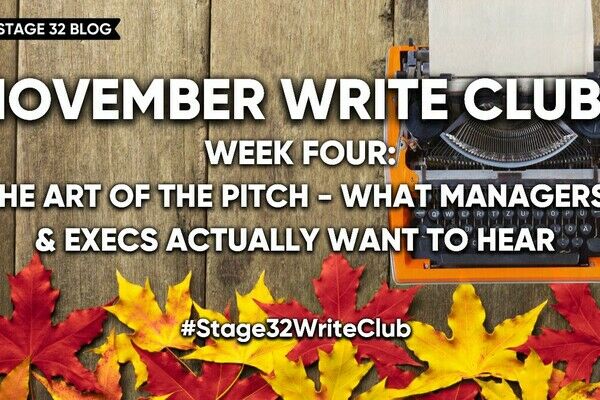Using Musical Composition To Craft Your Adaptation
The demand for adapting IP into film and television projects isn't ending anytime soon. Whether you're looking to adapt a book you've already written or a piece of material written by someone else, it's important to have a way a process to help you craft your adaptation into a screenplay. So, how do you do it?
A little background.
I have written five books and adapted them into feature-length screenplays. Two have been made into feature films and my latest novel/screenplay will be filmed next year. I have taught a college-level creative writing class for years and although there is really no set formula for a book adaptation, I have found that by using what I call the “Lee Shargel” musical method for a book adaptation, (my creation) to be a great route to a good screenplay. It might sound strange, but it works for me and for others, too.
I believe a book is like a symphony with you (regardless of who wrote it) as the composer and conductor. I have had the pleasure of seeing the New York Philharmonic Orchestra, conducted by Leonard Bernstein on many occasions and every time was an experience never to be forgotten. He was my source material.
So what is the “Lee Shargel method"?
It is my own invention for taking the printed word and making it come alive for the screen. It’s like transforming musical notes (words in this case on a printed page) into an image or a visual medium. Not easy, but if followed correctly, you can master what I call “composing a symphony of words” that form a picture with dialogue that flows through it.
Most important, the first and foremost thing you need to do is obtain the rights to adapt the book/short story/comic book into a screenplay. Depending on the book, this could be a costly endeavor. You not only have to consider the cost (your time and energy), but you need to find out who or what (entity) owns the rights. It may be an individual (usually the author) or a company or a publishing house. Whatever the case, it’s safe to say, GET THE RIGHTS before you write anything, and obtaining the rights will take some research.

Who Owns the Rights?
In most cases, the rights will be owned by the author. In my case, I own the worldwide rights to all my novels, short stories, artwork, and magazine articles. They could also be co-owned by the publisher, or if the author has passed away, it may be a family member or someone designated by the deceased author, an attorney, or another legal representative as well as the publisher. WARNING! Writing an entire script based on a novel or other medium may turn out to be a complete waste of time and energy if you do not have permission ("the rights") to publish it or use it as a basis for a short or feature film. So, before you go any further research the publisher first. If they own the rights to publishing only, inquire who you need to contact to acquire the film rights. But, and this is a BIG but, be careful how you ask. They may see dollar signs and that may nix the deal for you right from the get-go.
When you find out who owns the rights for a feature film based on the story you want to adapt, check to see what will be required by the rights owner. Depending on the answer, you may need to have an attorney get involved on your behalf. In my case the answer to who owns the rights to my books was easy. I own the film rights to all my published works. Please note, there have been cases where I have been asked to adapt a novel into a screenplay by the author and owner of the feature film rights. The owner of the rights agreed to allow the original screenplay to be edited by me. After fourteen iterations, my suggestions were approved. In many cases, a script doctor does not receive a credit for the film.
Okay, you have the rights to write your screenplay. Now what? After some in-depth research, you have been given permission to write the screenplay. Probably with some caveats. Negotiations and an upfront payment or promise of payment if it gets made into a feature film. There may also be a deadline attached to complete the script or you lose the rights. There may also be an approval clause attached to the agreement as well. If they don’t like it, (the people or entity that has given the permission) they may have the right to refuse to allow it to be made. They may want to have a say regarding the casting of the film. They may want to have a say in any number of things regarding the film’s production. This is especially the place where you need an attorney. I have looked at many books that explain how to adapt a novel into a screenplay. They outline tips from 10 to 50 (last count) and most are valid if not somewhat redundant. You need to decide what’s best for you. There are certain rules that must be followed as outlined but once you have done your research it’s time to compose your symphony of words.
It’s Music to my Ears
You don’t have to be a musician, composer, or conductor in order to write a screenplay that reads like “Music to My Ears.” Of course, you have to understand script structure, sentence composition, grammar, and dialogue. Thankfully, there are several good screenwriting software tools that can do most of the work for you. The most important thing you need to know is “How to Tell a Story.” A story that flows like music. Final Draft will format your screenplay to the industry standard, but the one thing these software tools cannot do is write an academy award-winning script. Believe me, if there were such a thing, we would all have statuettes polished and sparkling on our mantles.

The LEE SHARGEL Method
When you read a book that you want to adapt into a screenplay, imagine the scenes, the characters, and the unknown.
You are sitting in the front row alone in a theater. Behind the screen is an orchestra, a band, a single musician...
Every note is a word or scene. A character created by a happy flute or a monster that creeps out of the darkness of a base drum. When I wrote the screenplay adapted from my best-selling sci-fi novel, “Voice in the Mirror,” I was imagining an Astrophysicist alone in the lab at Goddard Spaceflight Center, looking at the images emerging from the Hubble Space Telescope. Pictures of the universe until that moment, never seen. But it was more. As the tempo increased its intensity, he realized this was impossible. The telescope was acting like a galactic telephone. A call was coming in from 26 light years away.
As I listened to the music, the scene became an interstellar musical composition. The words flowed like musical notes. I had characters in the string section who were different from the deepness of the characters portrayed by the percussion and brass. Then the full orchestra. Here is a quick lesson on how I compose my adaptation using: The Four Sections of the orchestra.
The four sections of the orchestra are strings, woodwinds, brass, and percussion. It also refers to the four movements of the piece. Slow for strings (with woodwinds and brass); slow for percussion; moderate for woodwinds and brass (with strings); and fast for the full orchestra. The title also refers to the four harmonic sections each of the movements is divided into. I place my characters into different sections. I do the same with each scene (locations). I created a musical Tagline that tells the story in small movements. Even my pitch flows like a short musical composition.
The tagline for my screenplay adaptation of my novel, “Voice in the Mirror”: The Hubble Telescope, man's greatest achievement at a cost of 8 billion dollars, is flawed. Stricken with near-sightedness, the images are hazy. As scientists and engineers appear to scramble to find a fix, something strange occurs. The telescope is receiving signals from a planet 26 light years away. Life has been discovered on another plant. The other planet is earth. They have discovered us.
As I wrote my adaptation, I let my characters move into their places in the orchestra. My protagonist had a very prominent place in the front row of the violin section. He was an impresario. My antagonist stood in the back, He was tall and dark. Pounding the base drum and crashing the gong with his mallet.
My screenplay characters came to life as the story played out before me. There were words that made my heart thump as a love story emerged from the pages of my novel. It was music as their love deepened. There was danger and the music became dark and thunderous as a conspiracy was discovered. My antagonist’s sound made me hide under the desk as I continued to type. On and on the music played as the words were transposed from my novel to a screenplay adaptation. some scenes changed as the band played on. Some characters were added as I listened to the Beatles play, “The Long and Winding Road.” Some characters emerged from the darkness an evil that could only be portrayed by the “Ride of the Valkyries” by Richard Wagner.
As I neared the end, “THE FOUR SEASONS” by Antonio Vivaldi guided me to the last sentence. The screenplay was finished.
For more tips on writing your adaptation, be sure to check out this great webinar!
Let's hear your thoughts in the comments below!
Got an idea for a post? Or have you collaborated with Stage 32 members to create a project? We'd love to hear about it. Email Emily at blog@stage32.com and let's get your post published!
Please help support your fellow Stage 32ers by sharing this on social. Check out the social media buttons at the top to share on Instagram @stage32 Twitter @stage32 Facebook @stage32 and LinkedIn @stage-32
| How Can You Sell Your Screenplay To Studios? |
| Ask Me Anything" with Stage 32 CEO Richard "RB" Botto: State of the Industry, Where We Are Headed - Now Available On-Demand |
Search Stage 32 Blog
There are now 4038 blog posts for you to enjoy. Search them all by tags below.
Acting, Advice, Cinematography, Coffee & Content, Composing, Contests, Distribution, Featured, Filmmaking, Financing, Inspirational, Networking, Producing, Screenwriting, Success Stories, Tips, Trending,Relevant Tags
Recommended Articles

Stage 32 Certification Featured In IndieWire!

How Stage 32 Script Services Make You A Better Writer

Stage 32 + DramaBox Join Forces to Launch World's First Vertical Drama Incubator

November Write Club Week 4: The Art of the Pitch- What Managers & Execs Actually Want to Hear

Don't Let the Momentum of November Write Club Die: How to Stay Active Into 2026 & Beyond!

Coffee & Content: Why Your Pitch Needs to Be Human

Insider Intel: Packaging your Project- The Chicken or the Egg Dilemma

Insider Intel: A-listers Are Dead. Long Live A-listers.

Stage 32 Now Certifying Centro de Portugal Film Commission!






